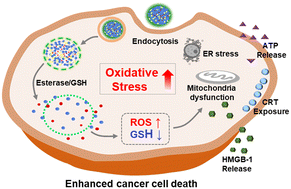Tumor-targeting oxidative stress nanoamplifiers as anticancer nanomedicine with immunostimulating activity†
Abstract
Compared to normal cells, cancer cells are more susceptible to insults of prooxidants that generate ROS (reactive oxygen species) or scavenge antioxidants such as glutathione (GSH). Cancer cells undergo immunogenic cell death (ICD) by elevated oxidative stress. Herein, we report rationally designed F-ssPBCA nanoparticles as a tumor-targeting prooxidant, which generates ROS and scavenges GSH simultaneously to cooperatively amplify oxidative stress, leading to ICD. Prooxidant F-ssPBCA nanoparticles are composed of a disulfide-bridged GSH scavenging dimeric prodrug (ssPB) that self-assembles to form nanoconstructs and encapsulates ROS-generating BCA (benzoyloxy cinnamaldehyde). F-ssPBCA nanoparticles significantly elevate oxidative stress to kill cancer cells and also evoke ICD featured by the release of CRT (calreticulin), HMGB-1 (high mobility group box-1), and adenosine triphosphate (ATP). Animal studies revealed that F-ssPBCA nanoparticles accumulate in tumors preferentially and suppress tumor growth effectively. The results of this study demonstrate that prooxidant-mediated oxidative stress elevation is a highly effective strategy to kill cancer cells selectively and even evoke abundant ICD. We anticipate that oxidative stress amplifying F-ssPBCA nanoparticles hold tremendous translational potential as a tumor targeted ICD-inducing anticancer nanomedicine.

- This article is part of the themed collection: Biomaterials Science Recent HOT Articles


 Please wait while we load your content...
Please wait while we load your content...